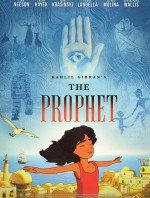?Dear Almitra, we don’t need to be afraid of death, for life and death are one, even as the river and the sea are one. How would we know the secret of death unless we look for it in the heart of life??
Back when I was in high school and college, Kahlil Gibran?s book The Prophet was very popular. It is a collection of prose poems about various aspects of life. It has a strong humanist view of life, but also a very spiritual understanding. You can good a good taste of the book in the animated film Kahlil Gibran?s The Prophet.
The film sets up a narrative to join together the somewhat kitschy philosophy found in the extended speeches from the book. In that narrative, Mustafa (voiced by Liam Neeson) has been under house arrest for the last seven years. His housekeeper Kamila (Salma Hayak, who also produced) has a troubled daughter, Almitra, who has not spoken since her father died two years ago. On one particularly difficult day Almitra follows her mother to work when she is befriended by Mustafa. When the authorities arrive to tell Mustafa that he is being released so he can return to his home country, the journey begins through the countryside and into town. Along the way, Mustafa encounters people and shares his thoughts on various topics: On Freedom, On Children, On Marriage, On Work, On Eating and Drinking, On Love, On Good and Evil, and On Death.
Each of these extended discourses has a different director and a different style of animation. These individual segments are all very interesting artistry. They are not so much depictions of what Mustafa is saying as they are emotive visual contemplations of the words being spoken. At times the visuals may be so mesmerizing that viewers may lose track of what is being said.
Gibran was born in what is now Lebanon, but grew up in the U.S. His thought is influenced by the Maronite Christianity of his birth home; as well as Sufism, a mystical branch of Islam; and by the Baha?i Faith, a syncretic religion that draws heavily on both Christianity and Islam plus Eastern religion. That makes the teachings shared in this film close to the teachings of many religions, but not easily identifiable with any particular religion. That is part of why the book was popular back in the days of the counterculture. It was a time when we thought the institutional church was dying and we sought to be in touch with the spiritual core of the church and its teachings. That time was really just the beginning of the phenomenon we hear so much about today?people who describe themselves as ?spiritual, but not religious.? Given how many people seem to understand themselves like that, this may be a fertile time for a new interest in Gibran?s work. This film provides a good introduction.
An interdisciplinary study guide for grades 6-12 is available at http://journeysinfilm.org/films/the-prophet/





